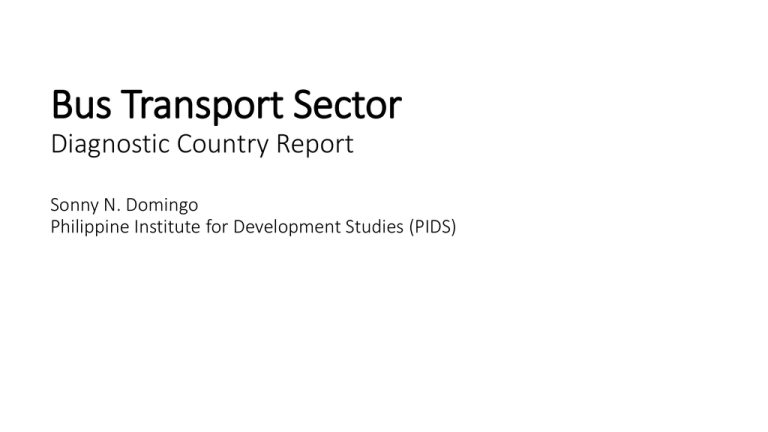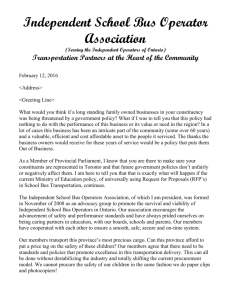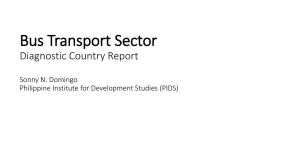Bus Transport Sector Diagnostic Country Report Sonny N. Domingo
advertisement

Bus Transport Sector Diagnostic Country Report Sonny N. Domingo Philippine Institute for Development Studies (PIDS) Metro Manila Key Statistics Policy and Institutional Timeline 1936 1950s Public Service law Public Service Commission DPWTC PSC transfers franchise powers to 1970s 1979 PUC becomes (PSC) Bureau of land transportation (BLT) Public Utilities Commission (PUC) Board of Transportation (BOT) Ministry of Transportation and Comm (MOTC) 1985 BOT and BLT merged Land Transportation Comm 1987 LTC replaced by LTFRB & LTO (LTC) Bus Transport Timeline 1975 • Metro Manila Transit Corporation / “Love Bus” • Government as largest operator with 701 units from 4000buses • Reorganization of >120 private operators into 4 consortia 1976-77 • Relaxed number of consortia to <10 • Bus operators regrouped to 14 consortia 1980-89 • Government-led bus leasing program ended the streamlined arrangement 1992 • Deregulation of Bus Transport (1992) • Supreme court ruling disallowing arbitrary fare change (1994) • Moratorium on issuance of new franchises 2003 • Moratorium lifting and policy accommodations allowed for entry legally and kabit/colorum illegally • Manila bus operators and buses total 1122 and 12595, respectively current • Prevalence of small operators averaging 10-14 units/operator/route Cost – Benefit Analysis Cost – Benefit Analysis MSCt (marginal social cost of congestion)= MECt + MBOCt The goal for traffic managers is to move traffic flows to optimal rates/levels (from V3 to β and V4 to α) where marginal social costs equal marginal social benefits. We estimate the movement in marginal social cost as traffic de-congestion is assumed given hypothetical policy augmentations. Cost – Benefit Analysis Transportas Consulting 2007 Lessons for Policy Vehicular volume is too immense for existing road infrastructure Unfettered sector evolution: Fragmented bus operators with oversupply of buses Inadequate regulatory enforcement results to illegal bus operations, poor traffic discipline, and safety concerns for riding public Regulatory bodies as institutional reincarnates; need structural augmentation and more trained personnel for enforcement Short Term: Cut vehicular flow through strict traffic management Long Term: Implement wide-spectrum approach, including infrastructure development and competition reforms Points for Advocacy Organize bus operators Look into the welfare of drivers and conductors Enforce policy and harmonize sectoral plans • Agglomeration allows for regulatory ease • Enhances accountability and in-sector policing • Boundary/ Commission system burdens the lowly worker • Assured daily wage will make drivers more compliant to traffic rules • Traffic management and enforcement • PDP/NTP (AusAid 2010)/MegaManila Roadmap (JICA 2014)/ DOTC- UP • JICA 2014: Infrastructure development:PHP 520 B short term/ 2,610 B long term THANK YOU !






